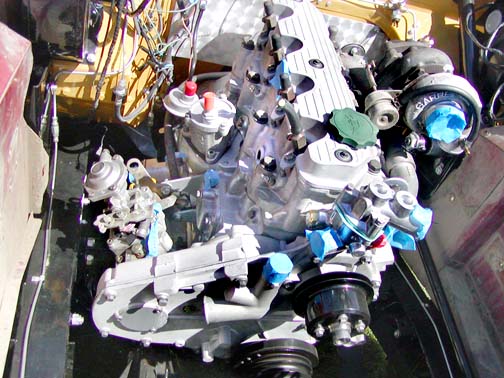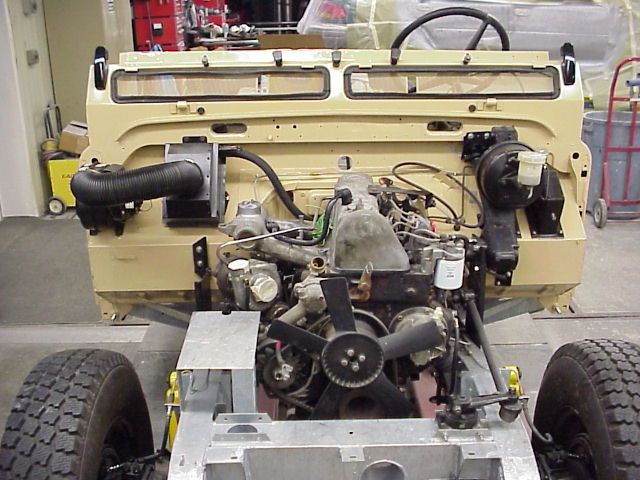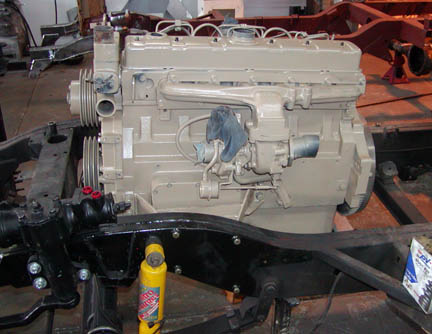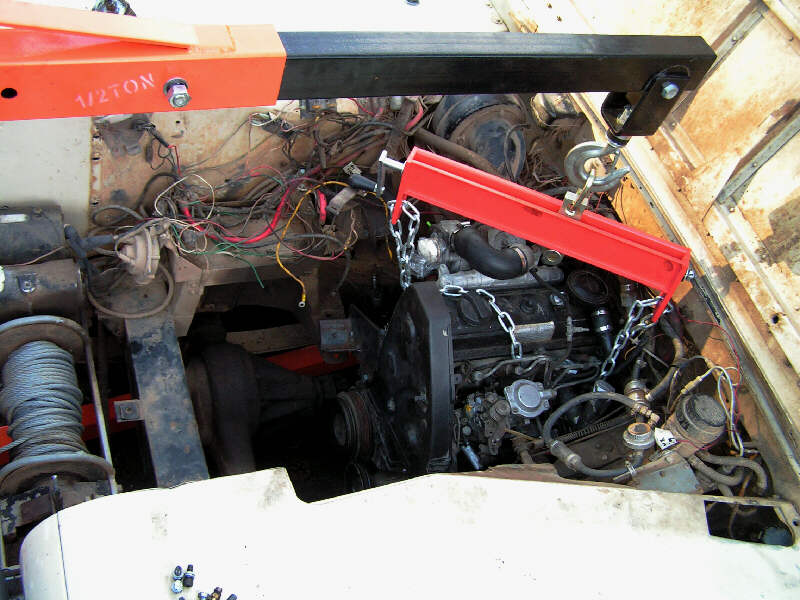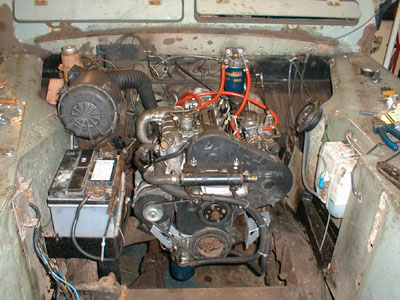
|
EARLY DRAFT PAGEBack in 1999 when The Green Rover was converted from a 2.25L petrol Land Rover engine to a 302 Ford engine I had wanted to convert to a diesel engine. I choose the petrol engine out of economics. First there are very few diesel engines that were sold in The United States that are good choices for a Land Rover, especially a heavy Dormobile camper with three fuel tanks & on board water tank. I wanted a fresh engine and except for the big GM 6.2 V8, a fresh rebuilt diesel engine would have cost me around $8000 (major rebuild kits for diesels often run $5000). I paid a little over $1000 for a fresh rebuilt 302 long block plus $300 for a core engine. Going with a fresh diesel engine would have about doubled my conversion costs. The diesels I was looking at would get approximatly 8 to 10 MPG more than a small block petrol V8 set up for economy. At the time diesel was a bit more expensive than mid grade grade petrol and my V8 is set up to run on cheaper regular. Running the numbers there was no way I could break even on fuel savings between rebuilds. I did not know that some diesels ran well on used french fry oil at the time. The question becomes do you spend a whole lot more money up front and pay a little less at each fillup or pay half as much up front and fill up more often when total conversion and operating costs slightly favour the petrol V8 set up for economy at 150,000 miles. When looking for a diesel engine be sure to carefully total the costs and be aware of hidden costs such as buying a 'good' condition used diesel that is tired and will need a rebuild before long or searching for a rare or NLA cylinder head or manifold if the one you have cracks. An engine with a good parts supply, available locally is by far and away your best bet. If you are willing to go through the effort of procuring and filtering used restraunt cooking oil year after year and you pick a diesel that tolerates usd french fry oil well, the solution is a no brainer. The diesel quickly becomes the cheaper option. But it would be real easy to get tired of collecting, filtering and storing your own fuel over time and just hop over to the filling station. Run the numbers before finalizing your decision. It the States, the economic cards are stacked against diesels. In the U.S. we are hampered by a very small diesel engine selection in the right size, weight and power range and the high cost of parts to rebuild a diesel engine. There are a new crop of potentially "just right" diesels on the near horizon, but they will require a lot of plumbing, electrics and the price of a newish engine will likely exceed the value of a Series rig for a while. There was a brief surge in automotive diesels for ligt trucks and passanger cars during the late 1970's and early 1980's The Japanese diesels disapeared from all but commercial trucks. American small truck diesels survived as an option and only Mercedes and Volkswagon kept diesels in some models of passanger cars. Small free revving diesel engines that can still be found inside the US include VW 1.5 and 1.9L fours (excellent engines but a bit on the small size for Series Land Rovers), Mercedes 616 (240D four cylinder, about the same HP as a 2.25L petrol but way less torque), Mercedes 617 five cylinder diesel (300TD, very difficult fit), A Mazda 4 cylinder diesel that was an option in small Ford Ranger pickups, LD28, a 2.8L six cyl diesel that was an option in Nissan Maximas, the Cummins AT6, a six cylinder diesel made by a company purchased by Cummins that was used as a diesel option for a Chevy inline six i small commercial vehicles and the SD33T (3.3L Nissan six cylinder diesel that was an option in the late international Harverster Scout II).
The Ford Powerstroke V8 diesels are big block V8s that are way too heavy for Series Land Rovers. The Cummins BT6 used in Dodge vans are too heavy & a tad too long for Most Series rigs, but I can not help but wonder how one would work in a Land Rover forward control. The GM 6.2 and 6.5 V8s are big block heavy engines but some people have managed to squeeze them into Series Land Rovers. I think this is likely because these are the cheapest readilly available diesel engines available to Americans with easy to get parts at a reatively inexpensive cost. I think there were one or two Toyota diesels briefly avvailable as options in Canada but I don't think they made it to the US market. There are people importing engines that were never sold into the States. These are always a possibility, but parts may be very difficult to obtain down the line, service might be nonexistant and in some there may be problems registering or transfering ovwnership of vehicles with some of these newer engines.
Diesels tend to be very heavy for their displacement.
-------------------------- The 6.2 GM diesel is about the cheapest that can be purchased in the US. But it is a GM big block engine that is wide, long and heavy. It barely can be made to fit in a series engine bay and will likely require 1 ton springs up front. The GM 6.5 is a bit bigger yet. For V8 diesels the GM 6.2 seems to be the best choice for Americans if you ever expect installation plus operating costs to exceed those of a petrol conversion.
eter Hope has managed to stuff a big 6.2 into a series bay. He has a web site describing his modifications. The following is an email from Peter Hope that provides a lot of detail about GM V8 diesel conversions. An excellent primer if you are considering going this route:
For the inline six cylinder diesel class, the old Cummins AT6 inline six cylinder engine seems to be the best conversion. Other inline 6's available in North America include the LD28 (Early 1980's Nissan Maxima) and the SD33 (Nissan 6 used as an option in late International Scouts). Modern Cummins engines like the 6BT used in Dodge trucks are a lot heavier and bulkier than the earlier engines. I have yet to hear of a successful conversion. The Mercedes 300D engine has a number of fit issues at frame level and would require a lot more engineering. However the engine weighs way less than the GM V8 diesels. it has a longer average time between rebuilds and gets significantly better fuel mileage If one could iron out the fit issues, put a 5 speed gearbox with granny & overdrive gearing behind it and set up the overall gearing properly this engine could well be the best of what is available in the U.S. There was a BMW 2.8L diesel used in some late model Land Rovers. This appears to be a nice engine and at least one Canadian company is importing the engine and stocking parts. But be prepared to spend at least US$5,000 for the engine alone. You can easily spend over $10,000 by the time you have the conversion on the road doing most of the work yourself. There might be import issues for use in a motor vehicle used on the road and you would have to import any part you need to maintain the engine. You can buy a lot of petrol for the difference in conversion costs. Of the four cylinder engines, the Mercedes 240D engine has been adapted but seems way underpowered for all but the lightest 88's. Here is an excerpt from an unsigned email I received from someone who had a 616 engine in a Land Rover Series I "Ive done the mercedes 240 D swap in a 49 80 inch. I used a factory remanned motor with about 40K miles on it. Ran sweet returned fair mileage. However, its a gutless motor. Its great for an 80, but not enough oomph for anything much larger. Under 100 ft/lbs of torque." On the plus side the engine is an easy fit with decent fuel milage, tolearates used french fry oil well and Seriestek makes an adapter that will make the engine to a Series gearbox.
The Ford/IVCO conversion is common in Europe and adaptor kits are available in LR magazines. Most of the commercial truck fours are narrow RPM band engines that are not suitable for a 4X4 but I never investigated them all. Four cylinder diesels tend to be bone shakers. Keep an eye out for newer diesel availability in the US. A wide revving V6 or V8 in the 3 to 4L size would likely be the ticket. Maybe the US will start seeing them after cleaner diesel becomes available in 2007. Since I didn't have a diesel conversion I never researched the nitty gritty nuts and bolts details. So back to my conversion: ----- The ideal engine in my opinion is the 2.7 liter five cylinder turbo diesel that is in the dodge sprinter UPS Trucks. Dimensionally it will fit in a Range Rover or a Series engine bay. I went for a ride in a loaded UPS truck that weighed 8000 lbs and it shot from 0 to 72mph (governed) in an alarmingly short time. Plus, amusingly, he averages 25 MPG in it on a day to day basis. These are hard to find and cost $7,000, but what an engine!????
|
|||||||||||||||||||||||||||||||||||||||||||||||||||||||||||||||||||||
|
If you would like to discuss any of the contents, or just say hi, please feel free to .
© 1997, 2001, 2017 TeriAnn Wakeman. All rights reserved. |

